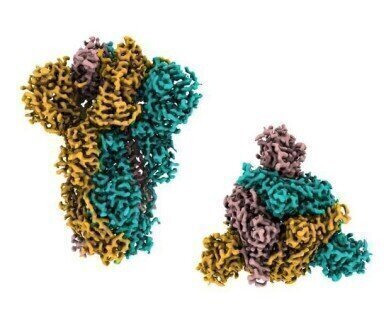-
 Cryo-EM images of the spike of Pangolin-Cov, showing two different angles (credit: Francis Crick Institute)
Cryo-EM images of the spike of Pangolin-Cov, showing two different angles (credit: Francis Crick Institute)
News & Views
Could Pangolins cause Coronavirus Infections in Humans?
Feb 23 2021
Structural similarities between SARS-CoV-2 and a pangolin coronavirus found by scientists at the Francis Crick Institute, suggest that a pangolin coronavirus could affect humans although it doesn’t rule out that another species may be a carrier of a coronavirus that will jump to humans. While SARS-CoV-2 is thought to have evolved from a bat coronavirus, its exact evolutionary path is still unclear as there are likely many undiscovered bat coronaviruses. Also due to differences between bat coronaviruses and SARS-CoV-2, it is thought that the virus may have passed to humans via at least one other species.
In the study(1), the scientists compared the structures of the spike proteins found on SARS-CoV-2, the most similar currently identified bat coronavirus RaTG13 and a coronavirus isolated from Malayan pangolins, seized by authorities after being smuggled to China. The pangolin virus was found to be able to bind to receptors from both pangolins and humans, while the bat coronavirus, could not effectively bind with human or pangolin receptors.
Antoni Wrobel, co-lead author and postdoctoral training fellow in the Structural Biology of Disease Processes Laboratory at the Crick, said: “By testing if the spike protein of a given virus can bind with cell receptors from different species, we’re able to see if, in theory, the virus could infect this species.
“Importantly here, we’ve shown two key things. Firstly, that this bat virus would unlikely be able to infect pangolins. And secondly that a pangolin virus could potentially infect humans.”
The team used cryo-electron microscopy to uncover in minute detail the structure of the pangolin coronavirus’ spike protein, which is responsible for binding to and infecting cells. While some parts of the pangolin virus’ spike were found to be incredibly similar to SARS-CoV-2, other areas differed.
The work does not confirm whether or not this pangolin virus is definitely part of the chain of evolution for SARS-CoV-2, but does support various possible scenarios for how the coronavirus jumped from bats to humans. One potential route is that SARS-CoV-2 originated from a different, currently unknown bat coronavirus which could infect pangolins and from this species it then moved to humans. Alternatively, RaTG13 or a similar bat coronavirus might have merged with another coronavirus in a different intermediate species, other than a pangolin.
Donald Benton, co-lead author and postdoctoral training fellow in the Structural Biology of Disease Processes Laboratory at the Crick, added: “We have shown that a pangolin virus could potentially jump to humans, so we urge caution in any contact with this species and the end of illegal smuggling and trade in pangolins to protect against this risk.”
More information online
Digital Edition
Lab Asia 31.2 April 2024
April 2024
In This Edition Chromatography Articles - Approaches to troubleshooting an SPE method for the analysis of oligonucleotides (pt i) - High-precision liquid flow processes demand full fluidic c...
View all digital editions
Events
Apr 22 2024 Marrakech, Morroco
Making Pharmaceuticals Exhibition & Conference
Apr 23 2024 Coventry, UK
Apr 23 2024 Kintex, South Korea
Apr 23 2024 Seoul, South Korea
Apr 24 2024 Jakarta, Indonesia







.jpg)









